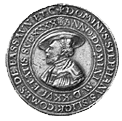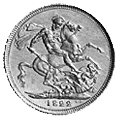Modern times
The modern age begins for numismatists with the coinage of large silver coins.


Grafschaft Schlick, 1 1/2 Taler 1526 (front and back)
Due to the discovery of rich silver deposits in the Bohemian minig town St. Joachimsthal and the riches of gold and silver in the new world of Latin America, a new era in coinage began. The counts of Schlick minted the coins in Joachimsthal which were known under the name of taler, a name still in existence today under the term dollar.


Reichsstadt, Schwäbisch-Hall Taler 1712 (left), Reichsburg Friedberg Konventionstaler 1766 (right)
The economic revival coincided with the production of numerous coin types in taler size.. Every mint master attempted depictions in even finer style and theme. Along with the portraits of rulers, saints and splendid city views were in vogue.


France, Double Louis d’or 1777 (front and back)
Gold coinage was minted in denominations of goldgulden, ducats, crowns, doubloons and pistols. The ducat remained Europe's most important gold coin into the 18th century.


Great Britain, Crown/Taler 1822 (front and back)
With the mechanical minting of the 19th century the attempted perfection in coinage was reached. The metal discs that are known to us today, one like the other, excepting the date, had been perfected.